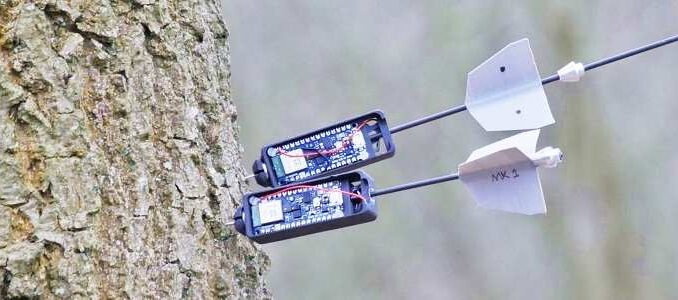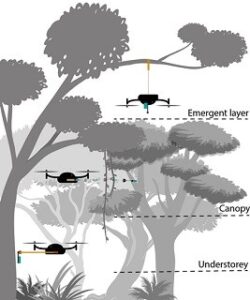
Views: 12
– Forest dwelling drones: A team of researchers from Empa and Imperial College London developed drones that can attach sensors to trees to monitor environmental and ecological changes in forests.
Courtesy EMPA by Caroline Brogan (ICL) and Andrea Six: Sensors for forest monitoring are already used to track changes in temperature, humidity and light, as well as the movements of animals and insects through their habitats. They also help to detect and monitor forest fires and can provide valuable data on how climate change and other human activities are affecting the natural world. Placing these sensors can, however, prove difficult in large, tall forests, and climbing trees to place them poses its own risks.
Flying robots à la Robin Hood
Now, a team of researchers from Empa and Imperial College London has developed drones that can shoot sensor-containing darts onto trees several meters away in cluttered environments like forests. The drones can also place sensors through contact or by perching on tree branches. The researchers hope the drones will be used in future to create networks of sensors to boost data on forest ecosystems and to track hard-to-navigate biomes like the Amazon rainforest.

Smart materials on the trigger
“Monitoring forest ecosystems can be difficult, but our drones could deploy whole networks of sensors to boost the amount and precision of environmental and ecological data”, says lead researcher Mirko Kovac, head of the Materials and Technology Center of Robotics at Empa and the Aerial Robotics Lab at Imperial. “I like to think of them as artificial forest inhabitants who will soon watch over the ecosystem and provide the data we need to protect these ecosystems.”
Unpredictable rainforest

The drones are equipped with cameras to help identify suitable targets, and a smart material that changes shape when heated to launch the darts, which then stick to the trees. They can also perch on tree branches like birds to collect data themselves, acting as mobile sensors. The researchers have tested their drones at NEST experimental robot testing space at Empa and on trees at Imperial’s Silwood Park Campus.
The drones are currently controlled by people: Using control units, the researchers watch through the camera lens to select target trees and shoot the darts. The next step is to make the drones autonomous, so that researchers can test how they fare in denser forest environments without human guidance. There are plenty of challenges to be addressed before the drones can be regularly used in forests, like achieving a careful balance between human input and automated tasks so that they can be used safely while remaining adaptable to unpredictable environments.
The research was funded by the Engineering and Physical Sciences Research Council (EPSRC), Offshore Robotics for Certification of Assets Hub (ORCA) EU’s Horizon 2020 and United Kingdom’s national academy of sciences The Royal Society.
Related article: Amazon – The limits of rainforest growth